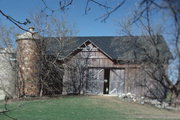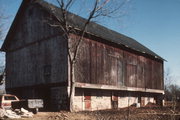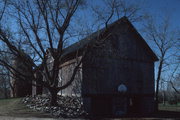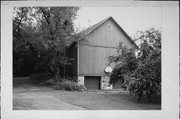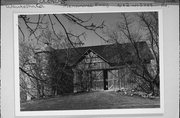Property Record
N72 W13449 GOOD HOPE RD
Architecture and History Inventory
| Historic Name: | Michael Wick Farmhouse and Barn |
|---|---|
| Other Name: | Thomas and Martha Shimek Barn |
| Contributing: | |
| Reference Number: | 68095 |
| Location (Address): | N72 W13449 GOOD HOPE RD |
|---|---|
| County: | Waukesha |
| City: | Menomonee Falls |
| Township/Village: | |
| Unincorporated Community: | |
| Town: | |
| Range: | |
| Direction: | |
| Section: | |
| Quarter Section: | |
| Quarter/Quarter Section: |
| Year Built: | 1889 |
|---|---|
| Additions: | |
| Survey Date: | 1993 |
| Historic Use: | barn |
| Architectural Style: | Astylistic Utilitarian Building |
| Structural System: | |
| Wall Material: | Board |
| Architect: | |
| Other Buildings On Site: | |
| Demolished?: | No |
| Demolished Date: |
| National/State Register Listing Name: | Wick, Michael, Farmhouse and Barn |
|---|---|
| National Register Listing Date: | 9/21/1988 |
| State Register Listing Date: | 1/1/1989 |
| National Register Multiple Property Name: | Multiple Resources of Menominee Falls |
| Additional Information: | See also AHI Record #0028735 Description: Generally described as a bank barn, the Michael Wick barn is built with the long side running along a rise located to the east of the structure. Covered with vertical board siding (formerly painted), the Wick Barn features a gabled dormer with ocular window and stick style ornament placed over the large sliding service door located at the top of the rise on the east side of the barn. The forebay, the projection of the upper story, extending the lenght of the barn over the stone foundation, is the dominant design feature of the west elevation. The lower level has several single entrance doors and windows on the west side and two large garage doors added in recent times on the north side. A tile silo, constructed c. 1920, and a concrete silo, constructed early in the 20th century, both with round metal roofs and ventilator caps, are located on the southeast corner of the barn. [D]. The farmhouse (WK 96/18) is also part of the property. Exhibiting post and beam construction on the interior and rather low ceilings, the lower level also features a stairway to the loft in the northwest corner. The barn now serves as a storage facility and horse stable. Probably constructed c. 1889 according to the inscription (date is unclear) noted a photograph dated c. 1900, the Wick Barn was part of a farm composed of 93.75 acres in 1909, when Michael Wick sold the family farm to his son, Fred Wick. [B, E, F]. Architectural/Engineering Significance: Obviously an important and interesting example of a 19th century barn, the architectural significance of the Wick Barn cannot be compared at this time because no context or basis for comparison in the Town of Menomonee is available at present. Hwoever, on the basis of integrity, the Wick barn is an architecturally significant example of a 19th century barn in the town of Menomonee. Historical Background: Michael Wick purchased his property (about 65 acres) in three separate tracts in 1869, 1872 and 1886, in the northeast quater, northwest quarter of Section 24 of Menomonee Township. He erected his dwelling on the northeast corner of the property in c. 1879 and the remaining barn in c. 1889. [2, 3]. The property (then 93-3/4 acres) was transferred to Frederick Wick in 1909. Michael Wick died in 1922. [11]. In 1941, the land was sold to Joseph Schmidt, and it was again divided into parcels. A farm auction occurred at this time. Thomas Shimek has owned the dwelling since 1973. [1, 2]. Shimek has refurbished the farmhouse, maintaining its original design. The recent rear wing is not visible from the front. Except for the c. 1899 barn, the remaining outbuildings were removed in 1974 to 1975. Michael Wick, son of Ambrose Wick who also owned a farm in the vicinity of Fussville, emigrated from Baden by 1850. In that year, the census lists Wick as a farm laborer and a member of his father's household. In 1860, he married Ann Ruhland, from whose father Wich purchased the 1869 tract which contained the dwelling. [1, 2, 8]. In 1870, the agricultural census indicates a very low level of production: 10 bushels of wheat, 50 bushels of corn, 150 bushels of oats, 1ox, 3 milk cows, 2 cattle and 1 sheep. He appears to have just begun his own farm; however, by 1880 Wick produced 435 bushels of barley, 300 bushels of corn, 200 bushels of oats, 260 bushels of wheat and 300 pounds of butter, as well as raising 5 milk cows, cattle and swine. [9]. He maintained a more mixed farm profile, probably producing wheat, barley, and butter as cash items. [10]. The c. 1889 frame, gable roofed barn resembles a southeast Pennsylvania German bank barn. Wick apparently gained familiarity with the design from his neighbors. The barn's spatial arrangement resulted from a meshing of similar traditions in America, from central Europe and Great Britain. Built from the late 18th century in Pennsylvania, the bank barn is a double crib barn with multiple stories. A cantilevered overhand over the first floor appears on the opposite side. The upper stories provide hay and grain storage, while the first floor contains animal stalls. [12]. Historical Significance: The Michael Wick Farmhouse gained local historical significance in relationship to the agricultural theme. The house and associated barn represent the development of agricultural patterns in the late 19th century. Between 1860 and 1870, Wick rapidly adjusted to local production patterns. Raising a minimal number of goods in 1870, he quickly incrased production by 1880. In addition, he also engaged in dairy farming, and raised a typically German crop, barley, rather than merely emphasizing wheat. Thus, unlike his Yankee and English neighbors but more characteristic of German farmers, he did adopt dairying, but cautiously maintained a more balanced production. [10]. The period of historical significance, prior to 1879 and before 1909, reflects his ownership of the farm. Another map code for this building is WK 96/16, found on the Engineer's Map of Menomonee Falls. |
|---|---|
| Bibliographic References: | A. "Milwaukee (Wisconsin) Journal," November, 1941. B. Deed Records, 124:412, 127:71, 304:288 (Waukesha, Wisconsin: Office of the Register of Deeds, Waukesha County Courthouse). C. Abstract of Property in possession of owner, T. Shimek, Menomonee Falls, Wisconsin. D. T. Shimek interview with the author, March 27, 1986, Menomonee Falls Wisconsin. E. Photograph of Wick Farmhouse, c. 1906, in possession of T. Shimek, Menomonee Falls, Wisconsin. F. Tax Records, Town of Menomonee, Wisconsin. Area Research Library, University of Wisconsin-Milwaukee, Wisconsin, 1849-1940. G. Historic name: Historic Resources of Menomonee Falls Survey Report. 1. No bibliographical reference given. 2. No bibliographical reference given. 3. No bibliographical reference given. 4. No bibliographical reference given. 5. No bibliographical reference given. 6. No bibliographical reference given. 7. No bibliographical reference given. 8. No bibliographical reference given. 9. No bibliographical reference given. 10. No bibliographical reference given. 11. No bibliographical reference given. 12. No bibliographical reference given. |
| Wisconsin Architecture and History Inventory, State Historic Preservation Office, Wisconsin Historical Society, Madison, Wisconsin |

